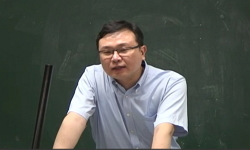이 글은 이청준의 축제를 브루노 라투르의 ‘허구의 존재자’ 개념과 미셸 칼롱의 ‘번역’ 이론에 기반해 분석한다. 축제는 장례라는 의례를 중심으로 다양한 존재들이 얽히�...
http://chineseinput.net/에서 pinyin(병음)방식으로 중국어를 변환할 수 있습니다.
변환된 중국어를 복사하여 사용하시면 됩니다.
- 中文 을 입력하시려면 zhongwen을 입력하시고 space를누르시면됩니다.
- 北京 을 입력하시려면 beijing을 입력하시고 space를 누르시면 됩니다.

허구의 존재자로 읽는 축제: 장례 서사의 번역 과정을 중심으로 = “Reading The Festival as a Being of Fiction: Focusing on the Translation Process of the Funeral Narrative.”
한글로보기https://www.riss.kr/link?id=A109770026
-
저자
임보람 (강원대학교 인문과학연구소)
- 발행기관
- 학술지명
- 권호사항
-
발행연도
2025
-
작성언어
Korean
-
주제어
Lee Cheong-jun ; The Festival ; FIC(Being of fiction) ; Funeral narrative ; Translation ; 이청준 ; 축제 ; 허구의 존재자 ; 장례 서사 ; 번역
-
등재정보
KCI등재
-
자료형태
학술저널
- 발행기관 URL
-
수록면
49-73(25쪽)
- 제공처
-
0
상세조회 -
0
다운로드
부가정보
국문 초록 (Abstract)
이 글은 이청준의 축제를 브루노 라투르의 ‘허구의 존재자’ 개념과 미셸 칼롱의 ‘번역’ 이론에 기반해 분석한다. 축제는 장례라는 의례를 중심으로 다양한 존재들이 얽히는 관계망을 형성하며, 감정과 기억, 인물과 사물이 끊임없이 상호작용하는 역동적인 서사를 구성한다. 본고는 칼롱의 번역 이론에서 제시된 네 단계—문제화, 관심화, 등록화, 동원화—를 장례의 서사 흐름에 적용해, 죽음을 둘러싼 관계들이 어떻게 조정되고 재배치되는지를 추적한다. 번역은 고정된 질서를 해체하고, 이질적인 행위자들 간의 연결을 통해 새로운 관계를 구성하는 네트워크 형성의 과정으로 작용한다. 축제에서 독자는 효, 죄책감, 상실, 돌봄 같은 정동에 감응하며, 텍스트와 함께 의미를 생성하는 참여자로 위치하게 된다. 이러한 관점은 문학을 고정된 의미를 전달하는 매체로 보지 않고, 독자와 함께 세계를 구성하는 하나의 존재로 이해할 수 있는 가능성을 열어준다.
다국어 초록 (Multilingual Abstract)
This paper analyzes Lee Cheong-jun’s The Festival through Bruno Latour’s concept of the “fictional being” and Michel Callon’s theory of translation. Centered on the funeral ritual, the novel constructs a dynamic network in which diverse bein...
This paper analyzes Lee Cheong-jun’s The Festival through Bruno Latour’s concept of the “fictional being” and Michel Callon’s theory of translation. Centered on the funeral ritual, the novel constructs a dynamic network in which diverse beings—people, objects, emotions, and memories—interact and reconfigure their relations throughout the narrative. By applying Callon’s four stages of translation—problematization, interessement, enrolment, and mobilization—the study examines how meaning and affect are continually reshaped through these interactions. Rather than delivering fixed messages, The Festival invites the reader to engage affectively and participate in the co-creation of meaning. In this view, literature emerges not as a static container of truth but as a relational and responsive mode of existence.
동일학술지(권/호) 다른 논문
-
에밀리 디킨슨의 종교시 읽기: “비스듬히 말하기”의 전략적 활용을 중심으로
- 한국문학과종교학회
- 유정화
- 2025
- KCI등재
-
“용기를 가지고 십자가를 지시오”: 기독교적 실존 철학으로 순교자 다시 읽기
- 한국문학과종교학회
- 박수정
- 2025
- KCI등재
-
- 한국문학과종교학회
- 한금윤
- 2025
- KCI등재




 KCI
KCI 코리아스칼라
코리아스칼라






